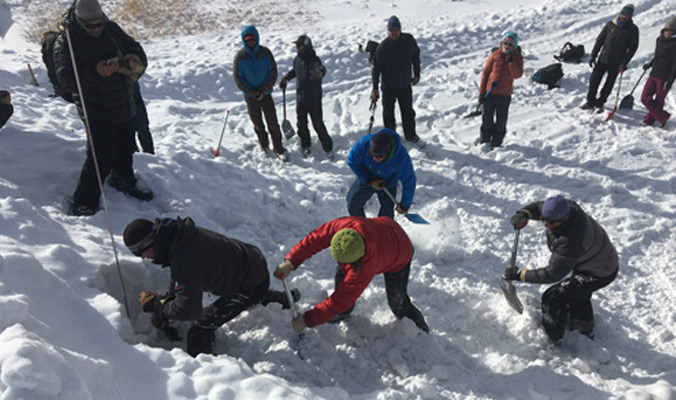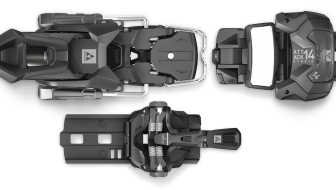We all know we should practice avalanche rescue more, but making it happen can be a sizable hurdle. Sometimes we try to bust out a couple laps in “search mode” at the beginning of the season to dust off the cobwebs. Other times, we’re lucky enough to have access to a beacon park at the resort, presenting a chance to practice our skill set before heading to more dangerous terrain.
But how do we know if we are sufficiently prepared for the season ahead? Finding a beacon placed six inches deep in a simulated burial does not necessarily translate to performing a successful real-life rescue. Here are a couple of ways to continue building skills until they become second nature.
![Doing efficient beacon searches takes practice. [Photo] Courtesy Steve Banks](http://backcountrymagazine.com/wp-content/uploads/2016/12/steve_mtn_skill_embed_1.jpg)
Doing efficient beacon searches takes practice. [Photo] Courtesy Steve Banks
Know Your Motivations
Beer
When heading out for a backcountry adventure, you might also be packing a cooler of frosty malt beverages for the tailgate après. Stick an old beacon in the cooler, bury it in the snow bank and then try to find it when you return to the parking lot. Your thirst will provide extra motivation for a quick recovery.
Football
Go buy a $10 Nerf football and cut it in half lengthwise. Then, hollow out an area to fit a beacon inside. Tape the two halves back together with duct tape and chuck the football (with transmitting beacon) over your shoulder into the powder and go find it.
This is a great way to practice by yourself. For bonus points, do it on a long, steep slope where you can throw the football out of the range of your searching beacon, forcing you to start with a true signal search and zig-zag pattern.
Know Your Tools
Avalanche rescue is more than just beacon practice. You need to be good with your probe and shovel, as well. The beacon gets you close to your buddy; the probe confirms his or her location; and shoveling will likely be the most difficult and time consuming part of the rescue effort.
Don’t be a Dummy—Get One
To practice probing, try to find an old CPR dummy from your fire department or EMS. If this proves difficult, take your old ski outfit from the back of the closet and fill it with rags, towels, newspaper or whatever else you can find. Bury this homemade dummy in the backyard, at the trailhead or somewhere else where you and your buddies can access it easily and repeatedly.
Practice quick assembly of your probe and drive it through the snow, being diligent about using the two-hand method and spiral technique until you hit the dummy. Remember, this session is about determining the difference between a rock, bush or ground and your buried friend. Pay attention to the feel of different probe strikes.
Got a big storm coming? Throw your dummy or an old backpack out in the yard and let it get buried. After slaying the pow all day, come home and probe the area until you find your target.

Digging can be difficult and tiring, so honing technique is key. [Photo] Courtesy Steve Banks
Dig Deep
For shoveling, a plowed up snow bank in a parking lot is a good substitute for avalanche debris. If you find old avalanche debris, pull out your shovel and see what it’s like, but if you don’t regularly see avalanche debris, you are probably making good decisions out there, so try this:
- Find a big snow bank, like the one the plow just buried your truck in. Drive two avalanche probes into the snow six feet back from the edge, six feet apart from each other and up to the 120cm mark on your probe.
- Now practice your strategic shoveling with the goal of finding just the tips of the two probes. This represents your buried buddy, not higher on the probes or deeper in the snow bank.
- Remember the keys to strategic shoveling. 1) Start back or downslope 1.5 times the burial depth; think about tunneling down and into the debris, not straight down on top of the “person.” 2) With multiple shovelers, work shoulder-to-shoulder chopping at the snow and clearing it to the side and downhill. 3) Use the conveyer-belt method to push snow from the front shovelers to the back shovelers, clearing debris farther to the side with each person and rotating through positions every minute like a defensive hockey line.
More is Better
Challenge yourself with multiple burials to help improve your single searches and to prepare for the worst.
- Gather up all the beacons in your group and do the standard beacon-in-the-glove method or one of the above ideas.
- See who can find the most beacons in two minutes, three minutes and/or five minutes.
- Now try it again, but when you find the first beacon, hit the marking/flagging button and then do 20 jumping jacks and 10 push-ups to represent the effort of shoveling before moving on to find the next beacon. Repeat and see how this effects your time and accuracy.
Bottom Line: The more you practice, the more it will feel like second nature if the time comes for a real rescue. Carry your beacon even when skiing inbounds, as most ski patrols have some sort of beacon park available to the public; even five minutes each time on the hill will help. Seek out professional instruction—many avalanche centers will do a free avalanche rescue seminar sometime during the winter. Hire a guide or avalanche-course instructor to put you and your buds through a one-day avalanche-rescue course. Split between four or five friends, the cost of a semi-private course is nothing compared to the repercussions of not being ready.
—
Steve Banks is an IFMGA/AMGA mountain guide based in Crested Butte, Colo. where he is the Director of Mountain Guide Operations at Irwin Guides. He has been a professional ski patroller and a forecaster and director of the Crested Butte Avalanche Center and is currently an Instructor Team member for the AMGA.










Related posts:
Mountain Skills: Ski Cutting a Slope
Mountain Skills: Jill Fredston on 20 years of education, safety and snow science
Mountain Skills: Karl Birkeland on 20 years of education, safety and snow science
Mountain Skills: Take the time to be prepared for early season turns